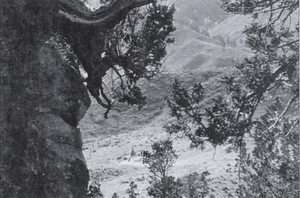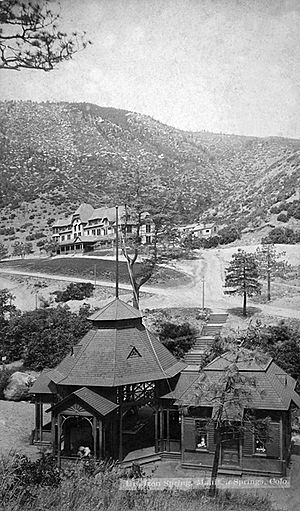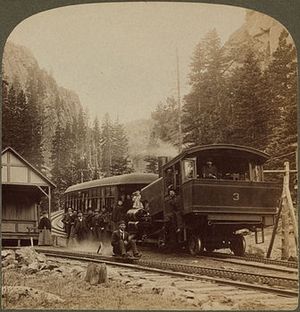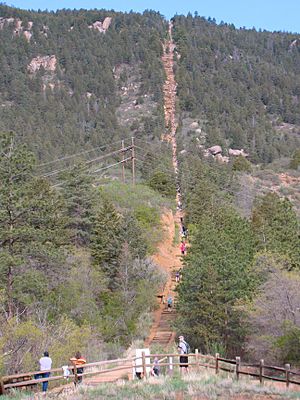Iron Springs, Colorado facts for kids
Iron Springs is a neighborhood in Manitou Springs, Colorado. It was named after one of the special Manitou Mineral Springs found there. Long ago, Native Americans thought the Manitou area was a sacred and healing place. They visited it often before European Americans settled in Manitou.
People started visiting Iron Springs in the 1870s, especially the Ute Iron Springs. In 1880, a new Iron Springs Hotel was built. There were many cool things to see and do in Iron Springs. These included an electric trolley, the mineral springs themselves, the Manitou Incline, and the Manitou and Pike's Peak Railway, which is a special cog railway. The Incline is now a popular hiking trail. The electric trolley and the Colorado Midland Railway are no longer in Iron Springs. However, the cog railway still runs today! Iron Springs became part of Manitou Springs in several steps between 1887 and 1934.
Contents
Where is Iron Springs?
The Iron Springs neighborhood is located in a lower part of Englemann Canyon. It sits right along Ruxton Creek. This area is also where you can find the start of hiking trails that lead to higher places. These trails include the Paul Intemann Memorial Nature Trail and the Barr Trail.
History of Iron Springs
The Special Mineral Springs
The Manitou Mineral Springs area has many mineral springs. Native Americans called them manitou, which means "breath of the Great Spirit Manitou." They believed this spirit created the bubbles in the spring water. The springs were considered sacred places. Native Americans would drink and soak in the mineral water to feel better and heal. Tribes like the Ute, Arapaho, and Cheyenne came to the area. They spent winters there and shared the "gifts of the waters" peacefully.
There were about 9 or 10 natural springs. As more white settlers moved in, there were some conflicts over who could use these special areas. Eventually, Native Americans were moved to reservations.
In 1820, explorer Stephen Harriman Long wrote about the water's healing power. His team's scientist, Edwin James, also noted the water's benefits. He was also the first European man thought to have climbed Pikes Peak. George Frederick Ruxton wrote about the "boiling waters" in his travel book. He understood how sacred the site was to Native Americans. Ruxton wrote that the spring's basin was "filled with beads and wampum." The trees around it were "hung with strips of deer skin, cloth and moccasins."
In the 1870s, a small building covered the Ute Iron Springs. This spring was thought to be a "strong tonic" because it had a lot of iron. In the early 1880s, the Iron Springs Company bought the spring. They built a wooden building over it. They sold the mineral water until 1887. That year, Joseph G. Hiestand bought the spring. In 1890, Hiestand tore down the old building. He built a new two-story structure. The second floor was a photography gallery. This spring was near the Iron Springs Hotel.
In 1910, Hiestand drilled the Iron Geyser on Ruxton Avenue. This helped with the operations of his Ute Iron spring. Hiestand owned the springs until he died in 1916. In the 1920s, William S. Crosby drilled two more springs. Their water mixed to make a sweet-tasting soda water called Twin Springs.
Today, the Manitou Mineral Springs on Ruxton Avenue include Iron Spring and Twin Spring. The Ute Iron Spring was covered up when the Iron Springs Chateau Melodrama Dinner Theater was built around 1964.
The Hotels of Iron Springs
In June 1880, an advertisement said the Iron Springs Hotel was very close to the Ute Iron Springs. It had been completely rebuilt and decorated with beautiful furniture. Charles A. Hubert was the owner. Sadly, the hotel burned down in July 1882.
In 1884, a large new Iron Springs Hotel was built by the Gillis Brothers. It was on Ruxton Avenue, where the Manitou Incline trailhead is today. The Gillis Brothers also built several cottages nearby. In 1885, the hotel started using a generator for electricity. This power was tested at the hotel before it was used in other parts of Manitou. That year, the hotel and cottages could serve over 200 people. They had hot and cold running water, steam heat, and electricity. H. T. Blake owned the Iron Springs Hotel in 1887 and 1888.
By 1890, Major John Hulbert, Jerome B. Wheeler, and M.A. Leddy bought the hotel for about $150,000. They planned to make the hotel even bigger. Joseph Hiestand owned the hotel by 1900 and when he died in 1916. The second Iron Springs hotel burned down in 1907 and was replaced again.
The Railways of Iron Springs
In 1880, construction began on a railway line from Colorado Springs to Manitou. This was a branch of the Denver and Rio Grande Western Railroad.
Around 1886 or 1887, the Colorado Midland Railway started operating along Ruxton Creek. This railway offered service between Manitou and Green Mountain Falls. It went through Ute Pass. The route was later extended to Leadville and Aspen. The Colorado Midland Railway helped resort towns in Ute Pass become popular in the 1890s.
In 1891, the Manitou & Pikes Peak Cog Railway was built along Ruxton Creek. It carried passengers all the way to the top of Pikes Peak. The Gillis Brothers built the train station. The station hasn't changed much from its original design, except for adding a lunchroom.
In 1895, the Colorado Springs and Interurban Railway started an electric trolley line. This trolley, called the "Dinky," took people from Manitou Avenue to the Manitou and Pike's Peak Railway station on Ruxton Avenue.
Historic Buildings and Fun Attractions
In 1880, a candy and cigar store opened near the Ute Iron Spring. The Iron Springs Company bought it, along with the spring. Joseph G. Hiestand was a big collector. In 1890, he gathered 40 tons of items like stones and petrified wood for his store. He ran a curio shop near the cog railway station. After he died in 1916, his stone collection was described as very interesting and valuable. The Iron Springs Chateau Melodrama Theater was built over the covered Ute Iron Spring. It started offering dinner and theater shows in 1964 and still does today!
In 1895, Hiestand and R.D. Weir leased a "new casino" near the Manitou and Pike's Peak Cog Railway station and the Ute Iron Spring. They added many things to the property. These included a bowling alley, billiard rooms, and a hard maple dance floor. They even built another building and connected the two with a fancy bridge on the second floor. It was decorated in a very grand way.
A Hydro-Electric Plant was built in 1905 at 540 Ruxton Avenue. It has a formal, modern look with red brick. It has two large arched windows with fanlights on the front. This plant, now called the Manitou Hydroelectric plant, helps make electricity for Colorado Springs. It uses water that flows through the Ruxton Creek area. After the water goes through the hydroelectric plants, it flows to a water treatment plant.
The Manitou Incline was built in 1907. It helped with the Hydro-Electric Plant operations. Materials were carried uphill to build pipelines on Pikes Peak. When the construction was finished, the trail became a cable car ride. It took visitors to the top of Mount Manitou, where there was a picnic area. In 1990, the track was damaged by a rock slide. The incline was closed, and the rails were removed. In 2013, it reopened as a one-mile hiking trail. It climbs about 2,000 feet (610 meters)!
Our Lady of Perpetual Help Catholic Church, at 218 Ruxton Avenue, was built in 1889. The church was destroyed by a fire in 1903. But it was rebuilt within just three months! The church is now a small Gothic and Shingle style building. It has a greenstone bridge that crosses over Ruxton Creek.
Becoming Part of Manitou
The road going up Ruxton Creek (Ruxton Avenue) became part of Iron Springs in September 1880. Different parts of Iron Springs were added to Manitou in February 1887, August 1893, and May 1934.





